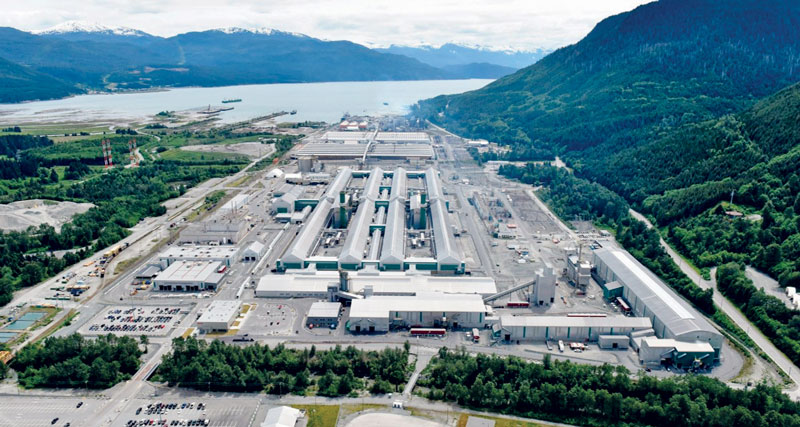The Closure of the San Ciprián Smelter is Increasingly Concrete
Alcoa and the social stakeholders cannot agree on the drastic reduction in the workforce requested by the company. The final destiny of the Spanish smelter will be known by the end of October
News coming from Spain further confirms the process of reduction of European primary aluminium production capacity, penalised by unsustainable operating and energy costs in the current situation of low aluminium prices and overcapacity. The most recent case concerns the smelter in San Ciprián, on the Spanish Atlantic coast, controlled by Alcoa, which last June had begun negotiations with the social partners to agree on the collective dismissal of 534 employees from the plant. Negotiations broke off without an agreement on September 28th, 2020, leaving little hope for the plant’s productive continuity, where the workers went on strike indefinitely. San Ciprián can produce more than 228,000 tonnes of primary aluminium per year, according to Alcoa’s 2019 Annual Report. The large industrial site also has an alumina refinery with a production capacity of 1.5 million tonnes per year. Doubts had been circulating for some time about the future of the Spanish plant, but the crisis materialised last June, in the midst of the Covid-19 emergency, when Alcoa began negotiations with the Spanish trade unions and institutions to proceed with a drastic industrial reorganisation plan to stop the aluminium plant’s serious financial losses. The American group’s intention is to stop the production of primary aluminium, with the consequent dismissal of 534 employees, and to keep on operating only the casthouse, a minimal part of the plant.
During the summer, an agreement had been reached with workers’ representatives to extend the end of the consultation period until September 28th, 2020. During this period, Alcoa had declared that it would consider a potential sale of the smelter to GFG Alliance, owner of the British steel and metallurgical group Liberty House. However, after a lengthy negotiation process, GFG Alliance and Alcoa did not reach an agreement. Alcoa actually stated that the possible sale should only concern the aluminium smelter, whereas the San Ciprián alumina refinery was not included in the sale process. At this point, for the Spanish plant the possibility of a definitive closure is becoming more and more concrete, even though Alcoa stated on 29 September that it was postponing the final decision for a few weeks: “Per an agreed-upon timeline, if a sales agreement was not reached by September 27th 2020, Alcoa and the workers’ representatives would then meet for one day to agree on a social plan that would include government-supported unemployment benefits (ERTE) or the implementation of a permanent collective dismissal. On September 28th, 2020, the workers’ representatives declined to agree on a social plan, and Alcoa has 15 days, per Spanish regulations, to make a decision”.

European primary aluminium is increasingly penalised
San Ciprián is the last smelter owned by Alcoa in Spain. In July 2019, the US group sold its Spanish plants in Avilés and La Coruña to Swiss private equity company Parter Capital Group, after declaring that producing primary aluminium in Spain was no longer profitable. Subsequently, Parter sold almost 75% of its capital to the Spanish company Grupo Industrial Riesgo. The restructuring of San Ciprián and the sale of the other Spanish plants appear to have come about as a result of weak prices in the global market and the reduction in processing premiums, which are severely compressing margins for producers. Alcoa itself pointed this out in its June note announcing the restructuring plan: “These structural problems include high energy costs and low aluminium prices, which, together with global overcapacity, have caused significant recurring losses, which should continue in the future. The European Works Council was informed of the informal consultation process at a meeting held recently”. Actually, the London Metal Exchange’s three-month aluminium contract has seen very low average prices per tonne in recent months. Values not seen since January 2016. In Europe, premiums for value-added primary aluminium products are at record low levels, which are unprofitable for most smelters. The premium for aluminium extrusion billet 6063, ddp Spain, was valued at $230-250 per tonne on May 22nd, the lowest since 2017.
Consequences also for the alumina market
Alcoa World Alumina and Chemicals (AWAC) – a joint venture between Alcoa (60%) and Alumina Limited (40%), owns and operates the San Ciprián alumina refinery. The refinery has an annual production capacity of 1.5 million tonnes of alumina, about 70% of which is currently destined for Alcoa’s smelter. Alumina market participants are concerned that the closure of the Spanish smelter would lead to an oversupply of alumina, further increasing price pressure at a time of scarce demand due to the crisis triggered by the Covid-19 pandemic.

